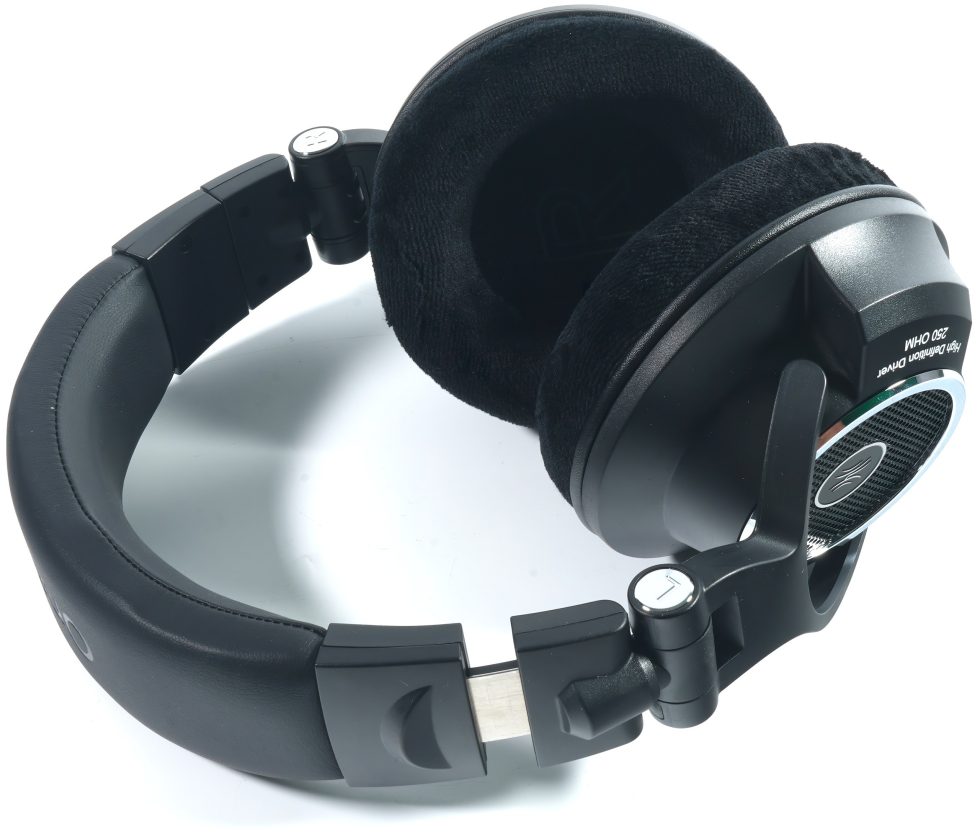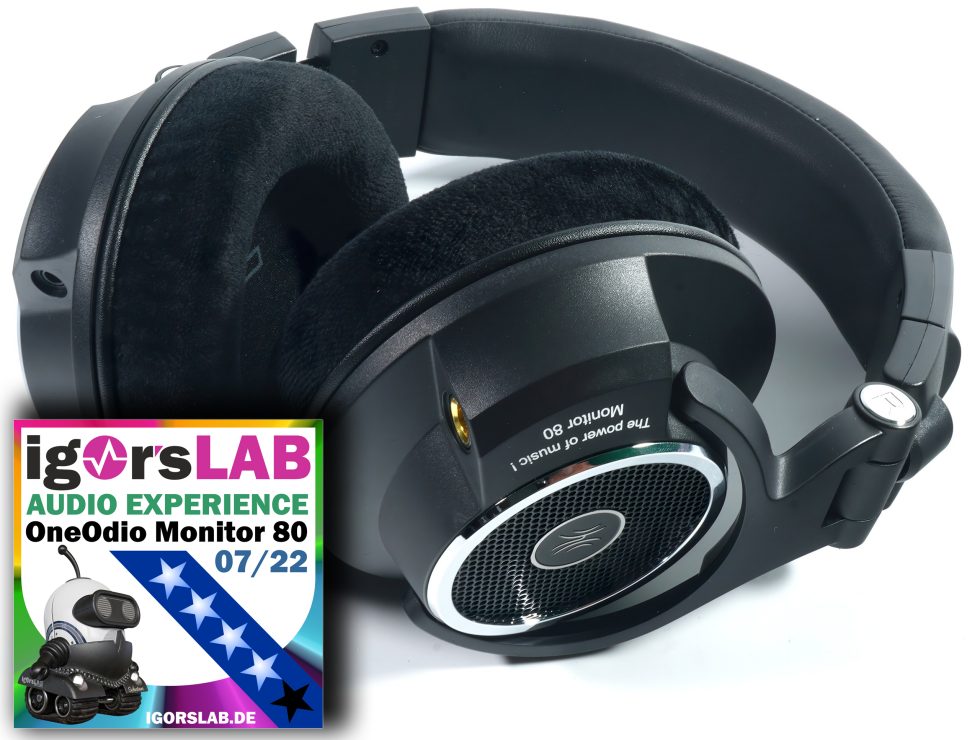After all the technical details, we finally get to the most important part: How does the OneOdio Monitor 80 sound? We now continue where it sometimes hurts even more: namely with the individual hearing test. The OneOdio Monitor 80 was diligently played in over days, so this argument is no longer applicable. I use my Tidal playlist with classical, jazz, rock, electronic music and various vocals (soul, choir music).
Bass range
Music: The OneOdio Monitor 80 doesn’t even fail with the subcontraoctave, but rather somewhat with the delivered level, which doesn’t deliver such concise results without manual tweaking on an equalizer. Nevertheless, it plays really deep and crisp. The small drivers do not tend to resonate, which is pleasing. The contraoctave, including the large bass drum, is a bit more dominant, but also remains dry as dust. Nothing hums or scrapes, not even in the slightest, but it remains free of ugly resonances. The bass is there, but for some a bit too anemic. Listening habits certainly play a big role here as well. The level stability is ok, but not extremely high. This is quite acceptable, but the OneOdio Monitor 80 runs out of breath faster than one would like, especially when using an EQ and larger manual bass boosts below 64 Hz.
Gaming: For gaming, the grenades could boom a bit more massively, but as long as you don’t overdo it with the level, you can still hear everything above the frequency range in parallel, which works surprisingly well. The differentiation of the individual sound layers and frequency ranges is really excellent here and you can easily beat any cheap gaming headset even without foregrounding. It doesn’t sound too loud, but it sounds nice.
Music: This area sounds refreshingly natural and is certainly one of the highlights of the OneOdio Monitor 80. The male vocals are modeled quite full and rich, but also remain completely dry as dust, which drifts somewhat into the coolness of the analytic. The instruments are also connected slightly undercooled, but this does not sound unpleasant, because cool does not mean cold, but rather restrained and not overemphasized. The OneOdio Monitor 80 sounds flatter and more neutral than the curve would actually suggest.
Gaming: That’s how gaming should be! No one needs the bathtub scuffle and human voices get a rock-solid foundation here. Some will wonder if the voice actors in the game are still the same. This is really striking in places and comes very close to the respective original.
Midrange
Music: This still sounds rich enough, but anything but too warm. As a result, many details of the fundamental frequencies remain close to the original and do not blur into a fireside ambience. You have to like that, of course, but this style of play is really well done. Female vocals don’t sound quite as confident in the foundation as the male ones, but that’s complaining on a very high level.
Gaming: The female vowels stay where they belong and always understandable. The fundamental range also has a nice foundation here, on which it can be built up well towards the top.
Music: It remains almost linear up to 1 KHz, which is very conducive to the differentiated reproduction. The stage is sufficient (though not brutely wide) and the subjectively perceived quality of the spatial resolution is on an extremely high level. You sometimes have the feeling that the vocals are right in front of you and that you are in the orchestra rather than far in front of it. Whether you like it or not remains to be seen, but it succeeds quite well. A large orchestra (from a purely subjective point of view) seems sufficiently wide in width, still well staggered in depth and also quite accurately positioned in total. However, high levels with many sources playing together are rather counterproductive, the localization then becomes increasingly difficult. So you have to turn it down or live with the light mud.
Gaming: Here, the level is not quite as critical; almost everything is as you would like it to be as a gamer. The localization of sound sources is really above average and even a loud thump in the bass range doesn’t push up to here, but everything stays firm.
Tweeter range
Music: The reproduction is not bad in terms of quality and it relies on the very good and almost neutrally well-modeled mids. The speech intelligibility as well as the quality of the vocals during recognition can absolutely convince. Only, for me personally, the whole thing is perhaps already a bit too dominant. Matter of taste, as always.
Gaming: Exactly the same applies here, the result can also convince in gaming. Perhaps it is also a bit too pointy and slightly cool, but that is less of a problem when gaming. You can almost hear more than is really there.
Music and gaming: The treble is good, but goes on the offensive again at 6 to 7 kHz. This creates an exaggeration known as the “Beyer Peak”. Sibilants and blow-off sounds are too superficial and everything slips a bit into the metallic and peaky. If the base tones are still pleasant and full, icy treble air already forms here. From about 10 KHz, however, the super high frequency runs out of air and from about 14 KHz it is really dark. Too bad. Had there been a bit more life here, it would have been a full and unqualified buy recommendation. But let’s be honest: Since Corona, bats are not really trendy anymore anyway.
Summary and conclusion
In individual listening, I would like to focus on two things. Even though the OneOdio Monitor 80 is supposed to be an analytical studio headphone according to the manufacturer – it is only a bit, but not quite. Anyone who wants to mix their own guitar pieces and some vocals, or record smaller orchestral groups, will be amazed and completely perplexed at how well it all works. You can also play well with the part and downright scare in some genres while sneaking (especially in the dark), which suddenly becomes audible (especially also very vividly modeled). You are really inclined to look around the room in fright because you think the sound event is coming from the real world and not from the game. That is terrific and probably very rare in this price range.
What the OneOdio Monitor 80 can’t really do, however, is large and also fixed levels. I do not mean loud, but the point at which the totality of all sound events is also reproduced as the original offers. Here, I’m a bit bothered by the spilling bass, which tends to “model” other frequency ranges quickly when overdriven even before audible distortions set in. And it is the slight loss of localization of individual sound sources when they occur in clusters and generally demand higher levels (orchestra in the grand finale). That’s when you really notice the 100 Euros.
However, it is also a fact that one could definitely come to terms with this, because no one will probably let the OneOdio Monitor 80 perform briefly from hearing loss for hours on end. Well, he doesn’t go that loud, but almost. The small 40 mm drivers are not a mismatch, especially because of the low settling times and the lack of resonances in the bass range, on the contrary. I am sure that the OneOdio Monitor 80 for the targeted price will certainly allow one or two readers to enter the world of open studio headphones and thus provide completely new listening experiences. I had the aha effect with the amazing details not only once, especially when gaming. Once you’ve grown fond of it, you’ll love the virtual 7.1. Surround sound sure to hate quickly. And that’s exactly why the 100 euros are certainly money well spent. Experiment successful, I would think.




































23 Antworten
Kommentar
Lade neue Kommentare
Veteran
1
Urgestein
1
Urgestein
1
Mitglied
Urgestein
1
Urgestein
Veteran
Urgestein
Urgestein
Urgestein
Urgestein
Mitglied
Urgestein
Urgestein
Urgestein
Alle Kommentare lesen unter igor´sLAB Community →